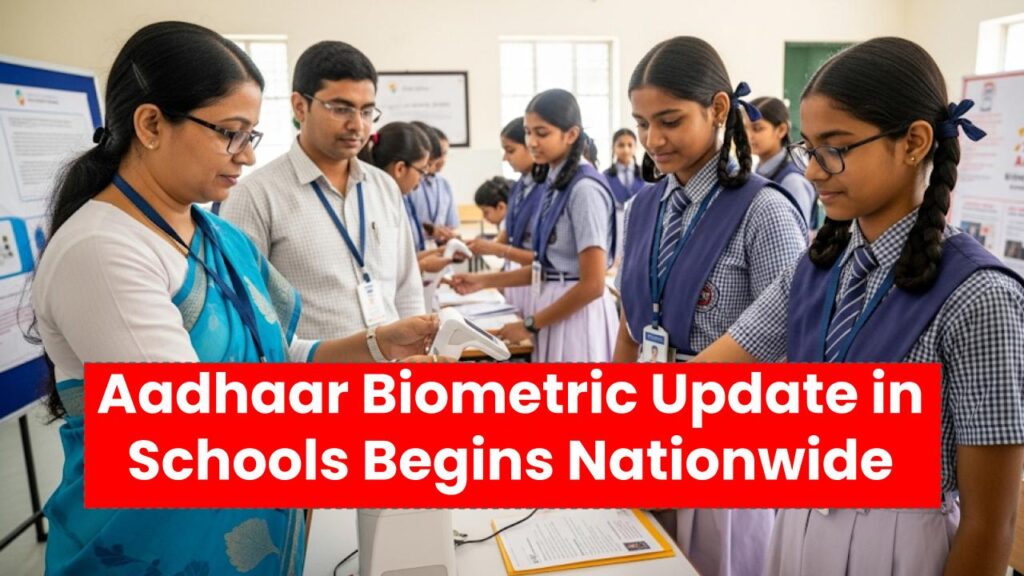The Aadhaar biometric update in schools has officially kicked off across India, sparking conversations from PTA meetings to WhatsApp groups. If you’re a parent, educator, or policymaker, this move affects you directly. Here’s the lowdown, broken down in plain English, so even your 10-year-old can catch on—but packed with enough insight to satisfy the sharpest minds in the room.

The Indian government, through UIDAI (Unique Identification Authority of India), is rolling out a school-based program to update children’s biometric data. The focus is on kids aged 5 to 7 years, ensuring they meet the Mandatory Biometric Update (MBU) requirement tied to Aadhaar, India’s universal digital ID system.
This isn’t just a routine checkup—if your child doesn’t update their biometrics on time, their Aadhaar number could get deactivated, affecting everything from school admissions to exam registrations and government benefits.
Aadhaar Biometric Update in Schools Begins Nationwide
| Topic | Details |
|---|---|
| Program Name | Aadhaar Biometric Update in Schools |
| Target Age Group | 5 to 7 years old (also later at age 15) |
| Deadline | Within 60 days of rollout (estimated by Sept 2025) |
| Cost | Free before age 7; ₹100 after |
| Risk of Inaction | Aadhaar deactivation, loss of access to services |
| Official Source | uidai.gov.in |
In a world where digital ID = access to life, this school-based Aadhaar biometric update is a welcome step forward. It brings convenience, compliance, and continuity to millions of Indian families. Take five minutes today to check your child’s Aadhaar status. A little prep now can save a mountain of trouble later.
Why This Biometric Update Matters
Aadhaar is a big deal in India—it’s the golden key for almost everything:
- School enrollments
- Scholarships
- Competitive exam registrations
- Bank accounts
- Health and food subsidy programs (like DBT)
But when a child turns 5 years old, their initial biometric data becomes outdated. Think about it: kids grow fast. Their fingerprints and iris patterns change, and so, to keep Aadhaar legit and functional, UIDAI mandates biometric updates at two key ages:
- First MBU: Between 5 and 7 years
- Second Update: At age 15
If this update doesn’t happen in time, the child’s Aadhaar can be deactivated. And with Aadhaar linked to 90% of social services, that’s a big problem.
What’s Changing in 2025?
In a new twist, the UIDAI is bringing the biometric machines straight to schools. Here’s how it works:
- Portable biometric kits are dispatched district-wise.
- These kits travel from one school to another, just like school health checkups.
- Parents must sign a consent form before the data is captured.
- Schools will notify parents of upcoming dates.
This school-based approach solves a major pain point: long queues and scheduling issues at Aadhaar Seva Kendras.
The Parent’s Guide: Step-by-Step
Let’s break it down, step by step, so no parent misses the boat.
Step 1: Know Your Child’s Age
Check if your child is between 5 and 7 years old. If yes, the update is free. If your child is older and hasn’t done the MBU, you’ll need to pay ₹100 at the Aadhaar Seva Kendra.
Step 2: Watch for School Notices
Schools will issue circulars and announcements. You may get an email, SMS, or a paper slip in your child’s backpack. Don’t ignore it.
Step 3: Submit Consent
You must sign a parental consent form. Without this, the school can’t proceed. Keep your child’s Aadhaar number and birth certificate handy.
Step 4: Confirm Your Mobile Number
Make sure your phone number is linked to your child’s Aadhaar. UIDAI sends alerts and OTPs to the registered mobile number.
Step 5: Post-Update Confirmation
Once the update is done, you’ll get an SMS. You can also check the Aadhaar status at resident.uidai.gov.in/check-aadhaar.
Real Talk: What If You Miss the School Drive?
No worries. If your child misses the school visit:
- Head to the nearest Aadhaar Seva Kendra.
- Carry the child’s Aadhaar card, birth certificate, and your own ID proof.
- Pay the fee (if applicable) and complete the update there.
Stats That Matter
- 7 crore+ children still haven’t completed their biometric update.
- Over 99% of adults in India have Aadhaar, but kids lag behind.
- India spends billions on welfare programs linked to Aadhaar. One glitch, and your child might lose out.
Professional & Legal Considerations
For Schools:
- Must comply with UIDAI guidelines.
- Should inform parents proactively.
- Maintain digital logs of completed updates.
For Government Bodies:
- Must ensure smooth logistics for machine rotation.
- Coordinate with local education departments.
Legal Framework:
- Under Section 6 of the Aadhaar Act, UIDAI can mandate biometric updates.
- Data collection must follow strict consent and data protection protocols.
FAQs
Q1: Is the Aadhaar biometric update mandatory?
Yes. It’s required by law for continued Aadhaar validity.
Q2: Is there any penalty for missing it?
Not a fine, but your child’s Aadhaar may become inactive, blocking services.
Q3: Can it be done online?
No. Biometric updates require physical presence.
Q4: My child is 6 and hasn’t updated yet. What do I do?
Wait for your school’s update schedule or visit an Aadhaar center now.
Q5: Will the data be safe?
UIDAI follows strict protocols, and data is encrypted during and after collection.








